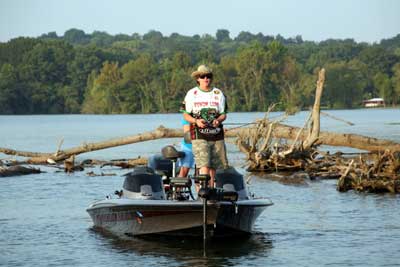Choosing A Fishing Rod
Intro
Buying a fishing rod is a confusing experience for the newcomer to fishing. There are many factors that need to be considered in order to make the right choice.
Your local tackle shop will be like an Aladdin's Cave filled with an overwhelming selection of rods, all of them designed and built to meet specific requirements. Here we explain the differing requirements that need to be considered in making the right choice of rod.
The Rod
The first thing to notice is that, whatever type of rod you are considering, there is a huge variation in price. Generally, as in all things, the more you pay, the more you get.
Gone are the days when fishing rods were made from natural materials, like split cane, and the modern rods available to the angler take advantage of modern materials technology, giving the angler a rod with superb characteristics at a reasonable price.
The structural material of choice for a modern rod is usually hollow section carbon, which may be multi-ply, low resin, or carbon composite. These carbon materials have a high strength to weight ratio and the resulting fishing rod will appear deceptively light considering its strength.
Spliced Tip Rods
Spliced tip rods were originally designed for river fishing, where the angler requires a fast response to strike into fast bites. To produce this fast action tip a tapered length of solid carbon is spliced into the rod's hollow tip section. The resulting rod has a very fast action. The middle and butt sections of a spliced tip rod are very similar in design to the hollow tip rod (see below). Because split tip rods were originally designed for river, and in particular, stick float work, they tend to have longer line guides. Meaning the line will be held well away from the rod blank. This ensures that a line can be trotted down stream unhindered by contact with the rod blank and possibly sticking to the rod.
Hollow Tip Rods
Due to production techniques employing today's advanced technology, hollow carbon tips now account for over 90% of all rods produced. Hollow tip rods can be manufactured to emulate the action of a spliced tip rod, making the spliced tip virtually redundant. The hollow tip can also be manufactured with a slower, softer action, making it the most versatile tip type available. These variations in tip action are achieved by using different thicknesses of carbon together with differing degrees of taper within the tip's hollow cross section.
There is a popular misconception that the tip action is responsible for extra casting power and more power when playing a fish. This is not true. Casting power and fish handling properties are governed by the middle and butt sections of a rod. The tip action governs the sensitivity, or control, of the strike.
Rod Length
The varying rod lengths that are available is often confusing to the novice angler. To arrive at the correct length you need to take into consideration the rod's intended use.
* Fishing at distance requires a longish rod. The extra length will provide better control when playing fish far out.
* Fishing close in to the margins, or in an enclosed space, requires a shorter rod.
* 12 or 13 foot rods are the most popular compromise for the average conditions encountered by most anglers.
* For canal fishing a shorter rod, about 11 foot, is better.
* Fishing deep water ideally requires a longer rod, up to 20 foot, but these are specialist rods. There are techniques for fishing deeper water with shorter rods.
Look for a rod with plenty of line rings, about 13 is normal, fewer line rings means that the line may stick to the rod in wet conditions, thereby inhibiting the free run of line.
Action
A fishing rod's action is the way the rod behaves during casting out and playing fish. In one situation you may be fishing light tackle on a waggler rod, on other occasions you may be casting out a heavy swim feeder. In the former situation you may be expecting to hook into smaller fish, and in the latter situation your expectations may be higher, bigger fish that can give your selected tackle some punishment. In either situation you need to be using the correct rod for the job in hand.
A rod's "Action" refers to the rod's degree of responsiveness to a bending force, and the speed with which the rod springs back to its neutral position. A rod action may be tip action, middle action, or through action. Fast action rods tend to have more flexion in the tip section. Slower rods tend to flex more towards the middle and butt end of the rod.
Test curve
A rod's test curve is the figure calculated by determining the weight required to bend the rod tip through 90. In other words, if the rod body is held horizontally, how much weight is required to bend the tip to the vertical position. The test curve tells the angler the power of the rod and hence the strength of line that the rod is suitable for.
As a general rule the line's breaking strain for use with a particular rod is approximately five times the rod's test curve. For example, a rod with a 2lb test curve: 2 X 5 = 10lb breaking strain line. However, a rod is usually considered to function correctly with a range of breaking strain lines. The lower limit of breaking strain for the rod is given by multiplying the test curve by four, the upper limit is given by multiplying by six. Hence a rod with a 2lb test curve would be suitable for lines with a breaking strain between 8lb and 12lb.
Line Guides
The purpose of line guides is to ensure that the rod bends through a smooth curve when subjected to stress being applied to the line. The spacing of individual rod rings is calculated to give the optimum curvature of a stressed rod.
A typical float or feeder rod will have more line guides than a heavy specimen rod. This is due to the fact that the lighter rods have a much softer action and hence need more guides to produce the correct curvature.
When a fish is being played a great deal of stress is applied to the line guides and the constant friction of the line being drawn back and forth through the guides produces heat. The simple stainless steel guide will retain this heat and this may damage the line at a critical stage of landing the fish.
Better quality lined guides have a lining material that is designed to disperse this heat.
Handles & Reel Seats
There are two types of material used to make rod handles, cork and Duplon. Handle lengths vary according to the type of rod on which they are used. Spliced tip or stick float rods tend to have shorter handles, enabling the angler to more easily manoeuvre the rod in front of their body while manipulating the float. By contrast a carp waggler rod will have a longer handle to facilitate casting heavy weights and handling heavier fish.
There are two types of reel seat, screw lock and split graphite. The majority of modern rods feature screw lock reel seats. The older type of split graphite needs constant attention and adjustment, whereas with the screw lock type, once secured, the angler can have confidence that the reel is solidly fixed in place.
Rod Joints
There are basically two types of rod joints, these being spigot joints and "put over" joints. A spigot joint can be used to joint two rod sections of equal diameter. A piece of carbon material in the shape of a dowel is glued into the male section, this can then be inserted into the female section.
Put over joints are where one rod section is larger in diameter than its adjoining section, so that one can be inserted into the other.
Blank Materials
The vast majority of modern rods are manufactured from one of two compounds, carbon or composite. Assuming similar dimensions, a carbon rod will be lighter, stiffer, and stronger than a composite rod. The composite rod will, however, be more flexible throughout its length, i.e., all composite rods tend to have a through action.
A carbon rod is manufactured from a compound of carbon and resin, the resin component, acting as a binder, will typically be about 30% of the overall mix.
A composite blank is made from a compound of glass fibre, a small amount of carbon to reduce the weight, and again about 30% resin binder.
Glass fibre is an extremely flexible material, this sensitivity being the reason it is used for light quiver tips.
How To Choose A Good Charter Fishing Boat
Learn Tips From Bass Fishing Games


